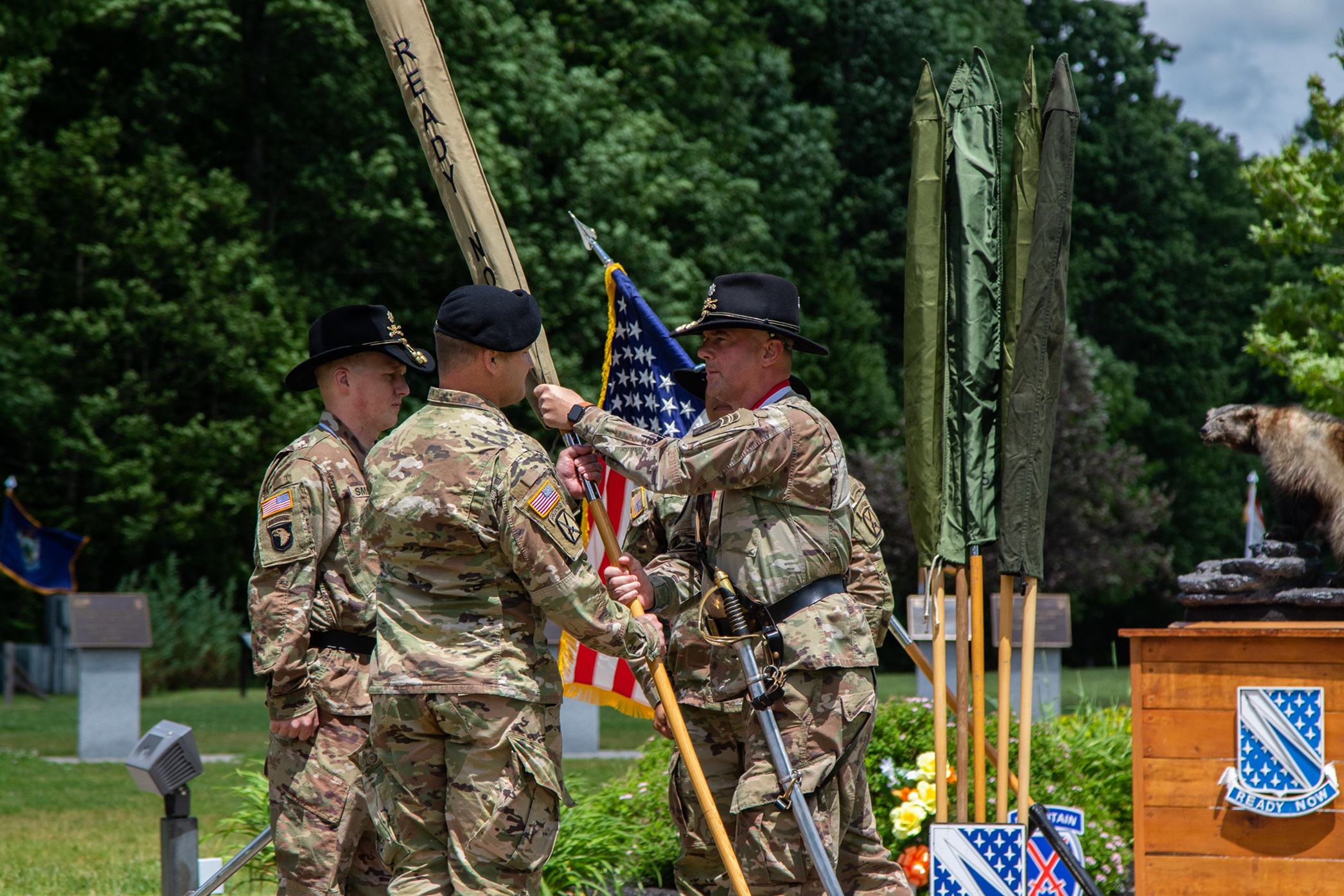
Lt. Col. Mike Andersen, who along with Command Sgt. Maj. Luis Villalobos served as command team of 1st Squadron, 89th Cavalry Regiment, 2nd Brigade Combat Team, 10th Mountain Division (LI), passes his unit’s cased colors to Col. Scott Wence, commander of 2nd BCT, 10th Mountain Division (LI), and Maj. Brian Smith, the current officer in charge of 1-89 Cavalry, during the unit’s inactivation ceremony June 7, 2024, in Memorial Park, on Fort Drum, New York. The 1-89 Cavalry was impacted by the Army Force Restructuring initiative that changed to modernize and transform the service to face future challenges. (U.S. Army photo by Spc. Kade M. Bowers)
10th Mountain Division cavalry unit formed during World War II inactivated at Fort Drum
Staff Sgt. Lawrence Holmes
27th Public Affairs Detachment
FORT DRUM, N.Y. (June 7, 2024) – Soldiers of 1st Squadron, 89th Cavalry Regiment, formerly known as the 899th Tank Destroyer Battalion, held an inactivation ceremony June 7 in Memorial Park on Fort Drum.
The 89th Cavalry Regiment originated on June 1, 1940, as the 10th Antitank Battalion. It was later redesignated as the 99th Infantry Battalion on July 1, 1940, and was activated at Fort Lewis, Washington. The 1-89 Cavalry took part in campaigns all over the world, including Tunisia, Normandy, Ardennes-Alsace, Central Europe, Kosovo, and most recently in Iraq and Syria supporting Operation Inherent Resolve in the U.S. Central Command area of responsibility.
The 1-89 Cavalry “Wolverines” deployed to Iraq and Syria in support of Combined Joint Task Force – Operation Inherent Resolve from July 2023 to April 2024. While deployed, the squadron was responsible for controlling the deconfliction zone from a critical, isolated outpost.
During Inherent Resolve, the squadrons efforts denied ISIS freedom of maneuver and furthered our national interests while repelling numerous attacks from Iranian-backed militias. As the strategic environment changed, the squadron was called into action as the Brigade Reserve, securing critical sites, systems, and capabilities in northern Iraq and into Syria.
The mood at the ceremony was one of reflection and triumph regarding the success and honors that the squadron has achieved throughout its history.
“We came fresh off a deployment, came fresh off a really hard training cycle, but it really is the culmination of a lot of hard work and dedication,” said Capt. Henri-Alexandre Noel, commander of C Troop, 1-89 Cavalry.
Noel also said that despite the unit’s inactivation, it was ending positively.
“It’s a bittersweet celebration of the troop and of the squadron,” he said. “We’re all shutting down but riding on a high note.”
Commitment to the mission are hallmarks of units around the Army, and that will continue for the Wolverines until its official inactivation date on Nov. 15, 2024.
Lt. Col. Michael D. Anderson, the Wolverines commander, summarized the unit’s final duties.
“Its mission is to shrink itself with a smaller group who will temporarily remain here for the purposes of clearing out the accounts, the motor pool, the barracks, turning in our equipment, and taking care of our people,” he said.
After highlighting many other accomplishments of his squadron, Anderson and thanked his troopers and especially Command Sgt. Maj., Luis J. Villalobos, the Wolverines senior enlisted adviser.
“I want you to know that my expectation of a command sergeant major foremost is to advocate for Soldiers as much as you advocate for the command philosophy, and you did,” Anderson said, praising Villalobos.
The history of the unit was on full display in Memorial Park as Stetsons and spurs of former Wolverine troopers were seen everywhere, evidence of the squadron’s proud and enduring history through its troopers past and present.
Sgt. 1st Class Jason W. Parker, Headquarters and Headquarters Troop first sergeant, spoke about the change and significance of 1-89 Cavalry’s inactivation.
“It’s a little bit unreal cause I’m retiring in the next nine months, so I am retiring from a unit that will no longer be in the military until it possibly gets reactivated,” he said.
Parker also reflected on the artifacts that signify the legacy of cavalry squadrons.
“The saber that I have, the emblem on my Stetson, and some of the other stuff that I have is historic now,” he noted.
Units like the Wolverines are casualties of the Army Force Restructuring initiative that will modernize and continue to transform the service to better face future threats and meet future challenges in increasingly complex environments.





